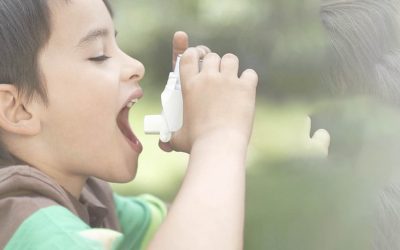Starting Solids to Prevent Food Allergies
In 2019, the Canadian Pediatric Society released updated recommendations about introducing common food allergens to babies to decrease the risk of food allergy.
Research shows us that to help prevent the development of food allergy in babies. Parents can offer non-choking forms of soli foods with common allergens (such as peanut butter and egg) between 4 and 6 months of age. This may reduce the risk of developing a food allergy.
Early allergen introduction is an effective way to prevent the development of food allergy infants. This is a significant change from previous advice regarding food allergy prevention and the introduction of allergens and solid food in general in a baby’s diet.
Most babies are eager and ready to start solid food before six months of age. Signs of developmental readiness include interest in watching you eat, leaning towards you when you are eating, trying to grab your utensil, and the ability to hold your head up and sit with support in an upright position.
With your healthcare provider’s support and guidance around food allergy prevention, most babies can begin to experiment with solid foods, as a secondary source of nutrition to breast milk or formula, after four months of age.
Here are some simple guidelines for starting solids for food allergy prevention
– Introducing solid foods early can decrease the risk of developing food allergies.
– Start offering solids as early as four months of age!
– Try to introduce as many allergens as you can between 4-6 months of age.
Once you start offering the allergenic foods, regularly maintain them in the diet to prevent food allergy! This can decrease the risk of future allergic reactions.
If an allergic reaction occurs, call 911, and review your child’s symptoms with their doctor. Allergy testing may be required.
Peanut
– You can offer peanut butter on a spoon to lick off or dilute with some water. This can decrease the risk of developing peanut allergies later on.
– Can dilute smooth peanut butter with warm water if the texture is too thick or sticky, or mix with fruit purées.
– Evidence suggests giving two teaspoons of peanut butter three times per week for allergy protection.
Eggs
– Many parents think we need to separate the yolk and the egg white. There is no reason to do so.
– A scrambled egg is the easiest way to introduce or hard boil and mash with a fork.
– Can dilute the scrambled or hard-boiled egg with breast milk, formula, baby food, or fruit or vegetable puree.
Milk
– If your baby regularly drinks formula, this counts as milk exposure (as long as it’s regular milk formula, not a hydrolyzed formula, nor the brand Good Start which only contains whey and not casein.)
– Or offer yogurt or shredded cheese or pieces of cheese.
– Some baby cereals contain skim milk powder, which counts as exposure, and can decrease the risk of milk allergy.
– Do not feed baby actual homo milk to drink until the baby is older (at least nine months).
– Whole cow’s milk cannot be offered till nine months of age.
Tree nuts
– Peanut allergy Includes almond, Brazil nut, cashew, hazelnut, pecan, pistachio, walnut, Macadamia nut, pine nut (technically a seed but still introduce it).
– Offer the baby nut butter or ground into crumbs or flour and mix it with cereals or fruit or vegetable purees.
– Once you do them each individually a few times, you can buy mixed nut butter to make it easier!
– The most important ones to prioritize: cashew, hazelnut, and walnut, as these are the most allergenic
– Cashew ‘covers’ you for pistachio since they are sister nuts
– Walnut ‘covers’ you for pecan since they are sister nuts
– Some mixed nut butter:
- Costco nut and seed butter (famous brand, but beware it does not include walnut or pecan)
- Trader Joe’s mixed nut butter
- Nutso
- Upaya Naturals extreme nut butter (expensive brand, but contains every tree nut)
- Peanut butter
Sesame
– Tahini or hummus (which contains tahini) is the easiest way to introduce
– Beware: some kids get contact with a baby rash from hummus because of the lemon juice and garlic.
– Beware that just eating sesame seeds (e.g., on bread) does not count as sufficient sesame exposure as there is not enough sesame protein!
– Sesame oil also doesn’t count as sufficient exposure.
Wheat
– For example, wheat cereal, bread, or other products made with flour.
– Note: ‘oat cereal’ or ‘barley cereal’ does not count as wheat.
– It needs to be natural wheat!
Soy
– Easy find products include tofu or edamame
– Can mush with a fork, or offer small pieces, or offer purees.
– Note “soy lecithin” or “soy sauce” doesn’t count as sufficient soy exposure.
Fish
– Clearly, you can’t introduce every single fish, so we usually suggest salmon, tuna, and a white fish (such as cod or halibut)
– Can fork mash or offer small pieces.
Shellfish
– It can be challenging to try every single shellfish
– Try to do at least one crustacean (such as shrimp, crab, or lobster) and at least one mollusk (such as scallop or clam)
Others
Not in the top allergen list, but we usually try to offer these foods early:
- Mustard
- Sunflower butter
- Coconut
- Legumes (lentil, chickpea, green pea, beans)
FAQs – Frequently Asked Questions
Can my baby be allergic to my breast milk?
Human breast milk typically does not cause allergic reactions in breastfeeding infants. Still, mothers sometimes worry that their babies may be allergic to something they eat and pass into their breast milk. Therefore, moms are encouraged to eat allergenic foods when pregnant and breastfeeding as long as the baby does not have a suspected or confirmed food allergy.
What is the most common solid foods allergy?
Food allergies can be a severe and life-threatening condition for some people, including children. The most common cause of food allergy in kids is peanut butter, tree nuts, egg, cow’s milk, wheat, soy products (such as edamame), fish, and seafood.
How do I know if my child is developing food allergies or has an allergic reaction?
A child with a food allergy will experience the following symptoms after eating certain foods:
- difficulty breathing, cough, throat or tongue itching or closing
- diarrhea, abdominal pain, or vomiting within minutes to hours of consuming allergy-causing foods.
Other common signs are :
- itchy red bumps on the skin known as hives
- losing consciousness
- swelling or the lips or eyes
Can an allergic reaction to food kill a baby?
If your baby is having trouble breathing, has swelling on their face or lips, develops severe vomiting or diarrhea after eating, or has decreased level of consciousness, call 911 immediately. These are the signs of an allergic reaction that could be fatal for them!
How long will my child be allergic to this food?
Some kids outgrow food allergies, and some are less common to outgrow. For example, 80% of those with milk allergies will eventually overcome their condition by age five; however, this isn’t always the case for other foods such as eggs (67%) or soybeans(74%).
What is in allergenic foods?
The Big-8 foods are a group of food items: milk, eggs, fish (including shellfish), crustacean, shellfish, tree nuts, peanuts, wheat, or soybean; these foods have the highest food allergies.
How do I know if my child is developing a food allergy?
If your child has a food allergy, call 911 and follow up with your doctor. Your pediatrician can diagnose which food allergies are causing the problem and help you develop treatment plans to prevent future allergic reactions, including medicines like adrenaline (Epipen) and antihistamines as needed!
What do I do if my child has an allergic reaction to other foods?
If your child has a severe allergic reaction to new foods or baby food, call 911 immediately for emergency medical help. After your child is treated, take an allergy test to avoid another allergic reaction.
#YouGotThis

Dina is a wife, mother of 4, and adrenaline junky. She loves to share children’s health information from her professional and personal experience. More About Dr Dina.














